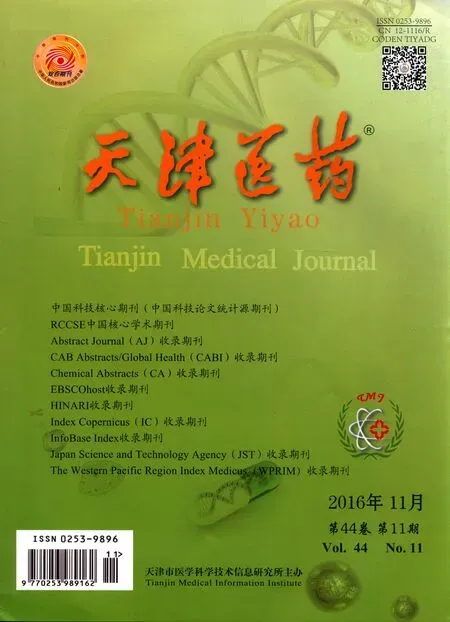高危型人乳头瘤病毒持续感染宫颈局部免疫状态的研究
张玲,宋华林,曲芃芃
高危型人乳头瘤病毒持续感染宫颈局部免疫状态的研究
张玲1,2,宋华林1,曲芃芃2△
目的探讨高危型人乳头瘤病毒(HR-HPV)持续感染过程中宫颈局部Th1、Th2、Th17相关细胞因子的变化及其与宫颈病变程度之间的关系。方法选取2015年11月—2016年1月我院阴道镜门诊有HR-HPV感染史的已婚妇女70例,按照感染情况及病理结果分为4组:转阴组(16例),无宫颈病变组(NSIL组,18例),低级别上皮内病变组(LSIL组,18例),高级别上皮内病变组(HSIL组,18例)。其中NSIL组、LSIL组、HSIL组合并称为持续感染组,LSIL组、HSIL组合并称为病变组。用流式BD-CBA法检测各组阴道灌洗液中白细胞介素(IL)-2、IL-4、IL-6、IL-10、肿瘤坏死因子(TNF)、γ干扰素(IFN-γ)及IL-17A的水平。根据病变程度、是否存在持续感染、持续感染状态下有无病变情况比较各组细胞因子的变化,同时分析Th2/Th1、Th2/Th17变化。结果随着病变程度的加重,IL-6的水平逐渐升高(P<0.05),LSIL组、HSIL组IL-2水平低于转阴组和NSIL组(P<0.05),其他细胞因子水平差异无统计学意义(P>0.05)。持续感染组与转阴组比较,病变组与NSIL组比较,均发现IL-6升高,IL-2降低。病变程度越严重,Th2/Th1、Th2/Th17越高。结论宫颈HR-HPV持续感染及宫颈上皮内病变的发生与宫颈局部免疫微环境密切相关。
人乳头瘤病毒;宫颈肿瘤;宫颈上皮内瘤样病变;Th1细胞;Th2细胞;细胞因子类;免疫微环境
子宫颈癌是妇女常见恶性肿瘤之一,其发病率在女性恶性肿瘤中居第3位,全球每年有新发病例53万、死亡病例27.5万[1]。流行病学证据显示,人乳头状瘤病毒(HPV),尤其是高危型HPV(HRHPV)感染与子宫颈癌和宫颈上皮内病变的发生密切相关[2]。有研究提出HR-HPV持续感染才会导致宫颈癌发生[3];另有研究指出,宫颈癌是由HPV感染后引发的机体与病毒之间免疫反应的共同结果,在宫颈病变发展过程中存在由Th1/Th2平衡向Th2方向漂移的现象[4]。HPV通过微创伤感染阴道局部,全身免疫反应轻微,因此阴道局部环境的免疫状态能更好地反映HPV感染后免疫反应的作用机制。本研究拟通过检测阴道灌洗液中辅助性T细胞(Th细胞)相关细胞因子水平,探讨HR-HPV感染与Th细胞分化之间的关系并分析Th细胞分化对宫颈病变进展的影响。
1 对象与方法
1.1 研究对象选取2015年11月—2016年1月就诊于天津市中心妇产科医院阴道镜门诊的有HR-HPV感染史的70例患者。按照HR-HPV感染状态及宫颈活检病理结果分为4组:(1)既往有HR-HPV感染,目前转阴(转阴组,16例)。(2)HR-HPV持续感染但无宫颈病变(NSIL组,18例)。(3)HR-HPV持续感染并有低级别上皮内病变(LSIL组,18例)(4)HR-HPV持续感染并有高级别上皮内病变(HSIL组,18例)。其中(2)、(3)、(4)组合并为持续感染组,(3)、(4)组合并为病变组。以感染持续时间>半年,且HR-HPV阳性≥2次定义为持续感染。各组间年龄及孕产次差异均无统计学意义(均P>0.05),见表1。入选标准:年龄20~65岁;有性生活史;无急性生殖道炎症;非月经期;3 d内无性行为及阴道用药。排除标准:患有自身免疫性疾病、非宫颈组织恶性肿瘤、严重内科疾病及肝肾功能异常者;妊娠或因其他原因行子宫次全切除术者;6个月内曾使用糖皮质激素、免疫抑制或免疫调节药物者。标本采集均经过研究对象同意并签署知情同意书。
Tab.1Comparison of the baseline information between different groups表1 各组基线资料比较

Tab.1Comparison of the baseline information between different groups表1 各组基线资料比较
均P>0.05
组别转阴组NSIL组LSIL组HSIL组F n 16 18 18 18年龄(岁)43.06±10.02 42.11±10.19 41.33±11.36 43.22±6.72 0.145孕(次)3.06±1.65 2.44±1.34 2.22±1.44 2.33±1.33 1.129产(次)1.06±0.57 1.22±0.81 1.06±0.73 1.17±0.51 0.261
1.2 方法
1.2.1 样本收集取5 mL灭菌生理盐水冲洗宫颈及阴道上1/3,停留10 s后于后穹窿处收集灌洗液4~5 mL(所有灌洗液中均不含血液成分),2 000 r/min室温离心5 min,留取上清液保存于-70℃备检。
1.2.2 标本检测采用流式CBA人Th1/Th2/Th17试剂盒(美国BD公司,货号560484)检测灌洗液中白细胞介素(IL)-2、IL-4、IL-6、IL-10、肿瘤坏死因子(TNF)、γ干扰素(IFN-γ)、IL-17A水平。操作步骤按说明书进行:充分混匀人Th1/Th2/Th17细胞因子捕获微球A1~A7,取2 mL实验稀释液溶解标准品小球,梯度稀释制备人Th1/Th2/Th17细胞因子标准品。每个管中加入50 μL混匀的捕获微球,标准品管中分别加入50 μL梯度稀释的标准品,实验管中加入50 μL待测样本,设置好参数后上机检测。
1.3 统计学方法数据采用SPSS 17.0软件进行统计学分析。计量资料采用均数±标准差表示,多组间均数比较采用方差分析,组间多重比较采用LSD-t法;2组间均数比较采用独立样本t检验,以双侧P<0.05为差异具有统计学意义。
2 结果
2.1 各组7种细胞因子水平比较(1)~(3)组IL-2水平逐渐降低(P<0.05),(3)组与(4)组IL-2水平差异无统计学意义;(1)~(4)组IL-6水平逐渐升高,差异有统计学意义(P<0.05);其他细胞因子各组间差异无统计学意义,见图1、表2。是否持续感染比较:持续感染组较转阴组IL-2水平降低,IL-6水平升高(P<0.05),见表3。是否病变比较:病变组较NSIL组IL-2水平降低,IL-6水平升高(P<0.01),见表4。

Fig.1The levels of cytokines in different groups detected by BD CBA图1 BD CBA检测各组细胞因子水平
2.2Th1、Th2、Th17细胞的关系随着病变程度的加重,(1)~(4)组IL-6/IL-2、IL-6/IL-17A均逐渐升高,组间多重比较差异有统计学意义(均P<0.05),见表5。
Tab.2Comparison of the levels of seven cytokines between different groups表2 不同组间7种细胞因子水平比较(ng/L,)

Tab.2Comparison of the levels of seven cytokines between different groups表2 不同组间7种细胞因子水平比较(ng/L,)
**P<0.01;a与转阴组比较,b与NSIL组比较,c与LSIL组比较,P<0.05
组别转阴组(1)NSIL组(2)LSIL组(3)HSIL组(4)F n 16 18 18 18 IL-2 7.70±0.62 7.26±0.44a 6.83±0.61ab 6.78±0.59ab 9.664**IL-4 4.46±0.57 4.32±0.53 4.43±0.52 4.50±0.61 0.354 IL-6 7.48±3.93 8.34±7.39a 21.84±13.61ab 43.55±20.07abc 11.635**IL-10 3.17±0.33 3.24±0.34 3.45±0.99 3.40±0.65 0.732 TNF 3.61±0.66 3.53±0.57 3.99±2.40 3.99±1.98 0.396 IFN-γ 3.13±0.41 2.96±0.32 2.95±0.45 3.03±0.37 0.791 IL-17A 11.16±3.04 10.95±1.82 11.95±4.51 12.08±1.83 0.626
Tab.3Comparison of the levels of seven cytokines between the negative group and persistent infection group表3 转阴组与持续感染组7种细胞因子水平比较(ng/L,)

Tab.3Comparison of the levels of seven cytokines between the negative group and persistent infection group表3 转阴组与持续感染组7种细胞因子水平比较(ng/L,)
*P<0.05,**P<0.01
组别转阴组持续感染组t n 16 54 IL-2 7.70±0.62 6.96±0.58 4.436**IL-4 4.46±0.57 4.42±0.55 0.132 IL-6 7.48±3.93 20.95±19.80 2.429*IL-10 3.17±0.33 3.37±0.70 1.094 TNF 3.61±0.66 3.84±1.80 0.503 IFN-γ 3.13±0.41 3.00±0.36 1.413 IL-17A 11.16±3.04 11.66±2.99 0.585
Tab.4Comparison of the levels of seven cytokines between the lession group and non-lession group表4 有无病变组7种细胞因子水平比较(ng/L,)

Tab.4Comparison of the levels of seven cytokines between the lession group and non-lession group表4 有无病变组7种细胞因子水平比较(ng/L,)
**P<0.01
组别NSIL组病变组t n 18 36 IL-2 7.26±0.44 6.80±0.59 2.865**IL-4 4.32±0.53 4.47±0.56 0.935 IL-6 8.34±7.39 27.26±21.07 3.682**IL-10 3.24±0.34 3.43±0.82 0.900 TNF 3.53±0.57 3.99±2.17 0.876 IFN-γ 2.96±0.32 2.99±0.37 0.314 IL-17A 10.95±1.82 12.02±3.40 1.249

Tab.5Comparison of the ratio of Th1/Th2/Th17 between different groups表5 不同组间Th1/Th2/Th17细胞比值关系比较
3 讨论
从HR-HPV感染到发生宫颈癌变大约需要10年的时间[5]。HPV侵入机体后,在引起感染的同时也会触发一系列的免疫反应,宫颈癌的发生是HPV与免疫反应共同作用的结果[4]。本研究通过检测阴道灌洗液中细胞因子水平来观察HR-HPV持续感染过程中宫颈局部免疫微环境的变化。Th1相关细胞因子主要包括IL-2、IFN-γ、TNF等,主要介导细胞免疫反应,有利于抵抗胞内病原体感染[6]。Th2相关细胞因子包括IL-4、IL-6、IL-10等,会对机体的抗肿瘤免疫产生干扰[7]。正常生理情况下,Th1、Th2两类细胞处于相互转化、相互抑制的平衡状态,一旦打破这种平衡,机体就会出现炎症、肿瘤等病理反应。研究发现在HR-HPV持续感染过程中存在Th1/Th2漂移现象[4,8-10]。本研究发现,HSIL组IL-6/ IL-2值明显高于其余3组,提示Th1向Th2漂移可能会促进宫颈病变进展。IL-2在HSIL组与LSIL组间无明显差异,提示其可能只参与HR-HPV持续感染的早期阶段,并不影响病变进展。
已有研究发现HR-HPV持续感染过程中会出现IL-10水平升高[11]。且Scott等[8]发现IL-10的水平上升会减少宫颈上皮内瘤变(CIN)2、3的发生。Baker等[12]发现TNF水平升高会促进HPV持续感染,而余杨等[9]发现随着宫颈癌病变的持续进展,TNF水平呈下降趋势。而本研究并未发现IL-10、TNF在各组间的变化差异,推测其原因一方面可能因为样本量较少,另一方面宫颈局部可能与外周血中细胞因子水平并不一致。Th17与调节性T细胞(Treg)比例失调会引起自身免疫性疾病及肿瘤的发生[13]。初始CD4+T细胞在TGF-β、IL-6共同作用下分化为Th17细胞,在TGF-β单独诱导下分化为Foxp3+Treg细胞。Th17细胞主要分泌IL-17A。童丹等[14]发现IL-6、IL-17在组织学水平与宫颈病变程度呈正相关。另有研究提示IL-17可以上调IL-6浓度,从而促进宫颈癌细胞生长[15]。本研究中NSIL~HSIL组中IL-6水平逐渐升高,与上述结果部分一致,但各组间IL-17A变化并不明显,需加大样本量继续观察。
综上所述,在HR-HPV持续感染至引起宫颈病变的过程中,阴道局部灌洗液能更好地反映宫颈局部的抗病毒效应。本研究同时检测多种因子,并分析各细胞因子之间的比例关系,有效地排除了取样方法上造成的误差。后期需要进一步扩大样本量,筛查出与HR-HPV持续感染及病变进展过程关系密切的因子,进一步对有意义的细胞因子进行信号通路的研究,为指导HR-HPV持续感染后的处理及预防宫颈鳞状上皮内病变的进展提供更多依据。
[1]Schiffman M,Solomon D.Clinical practice.Cervical-cancer screening with human papillomavirus and cytologic cotesting[J].N Engl J Med,2013,369(24):2324-2331.doi:10.1056/ NEJMcp1210379.
[2]Woodman CB,Collins S,Winter H,et al.Natural history of cervical human papillomavirus infection in young women:a longitudinal cohort study[J].Lancet,2001,357(9271):1831-1836.doi:10.1016/S0140-6736(00)04956-4.
[3]Rodriguez AC,Schiffman M,Herrero R,et al.Longitudinal study of human papillomavirus persistence and cervical intraepithelial neoplasia grade 2/3:critical role of duration of infection[J].J Natl Cancer Inst,2010,102(5):315-324.doi:10.1093/jnci/djq001.
[4]Hong H,Wang H,Jia CY,et al.Changes of concentration of immune inflammatory cytokines within cervical microenvironment infected with HR-HPV[J].Anhui Medical Journal,2014,35(1):9-12.[洪慧,王鹤,贾超颖,等.HR-HPV感染后宫颈微环境中免疫炎症因子变化[J].安徽医学,2014,35(1):9-12].doi:10.3969/j. issn.1000-0399.2014.01.003.
[5]Xie JY,Xie JN,Yu KJ,et al.The relationship between the load and duration of high-risk human papillomavirus and cervical lesion in pregnant women[J].Chinese Journal of Clinical Obstetrics and Gynecology,2015,16(6):550-552.[谢建渝,谢家宁,虞柯静,等.孕妇高危型人乳头瘤病毒载量和持续时间与宫颈病变的关系[J].中国妇产科临床杂志,2015,16(6):550-552].doi:10.13390/j.issn.1672-1861.2015.06.022.
[6]Andersen AS,Koldjaer Sølling AS,Ovesen T,et al.The interplay between HPV and host immunity in head and neck squamous cell carcinoma[J].Int J Cancer,2014,134(12):2755-2763.doi:10.1002/ijc.28411.
[7]Lippitz BE.Cytokine patterns in patients with cancer:a systematic review[J].Lancet Oncol,2013,14(6):218-228.doi:10.1016/ S1470-2045(12)70582-X.
[8]Scott ME,Ma Y,Kuzmich L,et al.Diminished IFN-gamma and IL-10 and elevated Foxp3 mRNA expression in the cervix are associated with CIN 2 or 3[J].Int J Cancer,2009,124(6):1379-1383.doi:10.1002/ijc.24117.
[9]Yu Y,Zou JJ.Relationship and clinical significance between T helper cell and cervical lesions among patient with high risk of HPV infection[J].Chinese Journal of Women and Children Health,2016,7(2):51-54.[余杨,邹晶晶.高危型人乳头状瘤病毒和Th细胞因子与宫颈病变的关系及意义[J].中国妇幼卫生杂志,2016,7(2):51-54].
[10]Liu K,Zhao JQ,Jiang B.Analysis of the drift of Th1/Th2 type cytokines of peripheral blood CD4+T lymphocytes in patients with cancer pain[J].Journal of Cancer Control and Treatment,2009,22(3):250-253.[刘坤,赵金奇,江波.癌痛患者外周血CD4+T淋巴细胞Th1/Th2漂移检测与分析[J].肿瘤预防与治疗,2009,22(3):250-253].doi:10.3969/j.issn.1674-0904.2009.03.005.
[11]Zhang M,Xiao FY,Li B,et al.Correlation between high-risk HPV infection and γ-interferon and interleukin-10 expression in cervical lesions[J].Journal of Hainan Medical University,2015,21(5):772-774,777.[张敏,肖凤仪,李波,等.高危型HPV感染与宫颈病变组织IFN-γ、IL-10表达的相关性研究[J].海南医学院学报,2015,21(5):772-774,777].doi:10.13210/j.cnki. jhmu.20150116.015.
[12]Baker R,Dauner JG,Rodriguez AC,et al.Increased plasma levels of adipokines and inflammatory markers in older women with persistent HPV infection[J].Cytokine,2011,53(3):282-285.doi:10.1016/j.cyto.2010.11.014.
[13]Tang MW.Study on the regulation of Th17/Treg cells and related cytokines[J].J Hexi Univ,2015,31(2):80-83.[汤美雯.Th17/ Treg细胞及相关细胞因子平衡调节的研究[J].河西学院学报,2015,31(2):80-83].doi:10.13874/j.cnki.62-1171/g4.2015.02. 014.
[14]Tong D,Song WJ.Expressions and clinical significances of IL-17,IL-6 and TGF-β1 in cervical intraepithelial neoplasia and cervical cancer[J].Chin Matern Child Health Care,2014,29(24):3984-3986.[童丹,宋文静.IL-17、IL-6和TGF-β1在宫颈上皮内瘤变和宫颈癌中的表达及临床意义[J].中国妇幼保健,2014,29(24):3984-3986]. doi:10.7620/zgfybj.j.issn.1001-4411.2014.24.45.
[15]Gosmann C,Mattarollo SR,Bridge JA,et al.IL-17 suppresses immune effector functions in human papillomavirus-associated epithelial hyperplasia[J].J Immunol,2014,193(5):2248-2257. doi:10.4049/jimmunol.1400216.
(2016-06-13收稿2016-09-10修回)
(本文编辑胡小宁)
Study on local immune status in women with cervical persistent infection of high-risk human papillomavirus
ZHANG Ling1,2,SONG Hualin1,QU Pengpeng2△
1 Tianjin Medical University,Tianjin 300070,China;2 Tianjin Central Hospital of Gynecology and Obstetrics△
ObjectiveTo explore the changes of cervical local cytokines Th1,Th2 and Th17 in the process of high risk human papillomavirus(HR-HPV)persistent infection and their relationship with cervical lesions.MethodsA total of seventy married women who were referred to colposcopy clinic in our hospital from November 2015 to January 2016 were included in this research.According to the HR-HPV infection status and pathological results,patients were divided into four groups:the cleared group(n=16),no squamous intraepithelial lesion group(NSIL,n=18),low-grade squamous intraepithelial lesion group(LSIL,n=18)and high-grade squamous intraepithelial lesion group(HSIL,n=18).The NSIL group,LSIL group and HSIL group were merged into the persistent infection group,while the LSIL group and HSIL group were amalgamated into the diseased group.The concentrations of interleukin-2(IL-2),IL-4,IL-6,IL-10,IL-17A,tumor necrosis factor(TNF) and γ-interferon(IFN-γ)in vaginal douche were measured by BD cytometric bead array.The changes of the above cytokines and the relationship between Th2/Th1 and Th2/Th17 were analyzed according to the severity,persistent status and disease status.ResultsThe levels of IL-6 increased significantly with the severity of disease(P<0.05),while the levels of IL-2 were decreased significantly in LSIL group and HSIL group compared with those of the cleared group and NSIL group (P<0.05).The other cytokines showed no significant differences between the four groups(P>0.05).Compared with the cleared group,the level of IL-6 increased and IL-2 decreased in persistent infection group,which showed a same results in the diseased group compared with NSIL group.The more serious of the diseases,the higher levels in Th2/Th1 and Th2/Th17. ConclusionThe persistence of HR-HPV infection and the occurrence of cervical intraepithelial lesion are closely related with the cervical local immune microenvironment.
human papillomavirus;uterine cervical neoplasms;cervical intraepithelial neoplasia;Th1 cells;Th2 cells; cytokines;immune microenvironment
R711.74,R737.33
A
10.11958/20160549
天津市卫生行业重点攻关项目(15KG140);天津市科技计划项目(09ZCZDSF03900)
1天津医科大学(邮编300070);2天津市中心妇产科医院
张玲(1990),女,硕士研究生在读,主要从事妇科肿瘤研究
△通讯作者E-mail:Qu.pengpeng@hotmail.com

